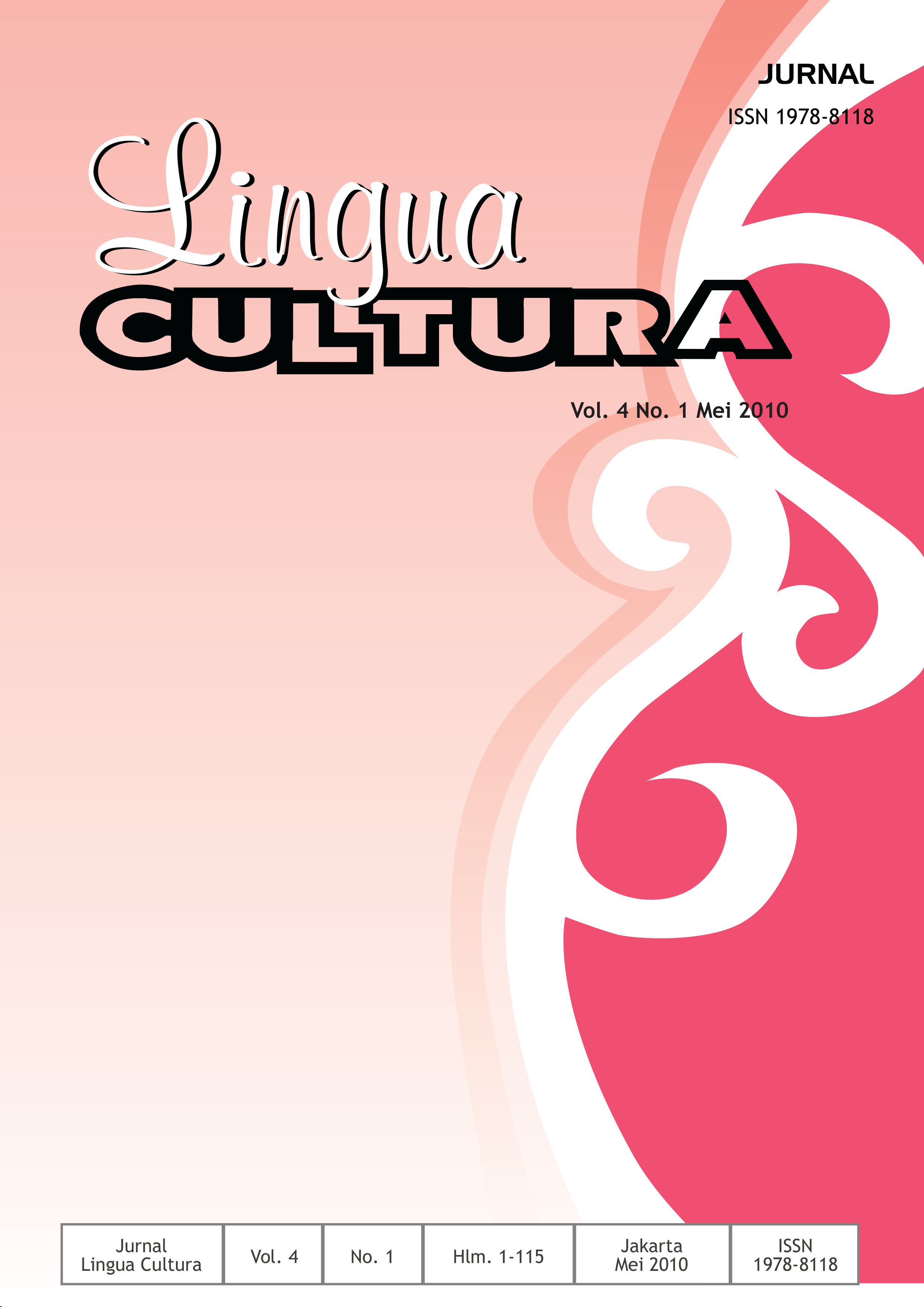Perbedaan Penggunaan Toritatejoshi ‘Dake’ Dan ‘Bakari’ Dalam Novel Sakura House Karya Shizuko Toudou
DOI:
https://doi.org/10.21512/lc.v4i1.356Keywords:
toritatejoshi, dake, bakari, Sakura HouseAbstract
An individual who only has little knowledge on grammar may use nouns, verbs, and adjectives in Japanese easily this is not the case with particles. Particles cannot be replaced or used at whim. This is the case with the particles ‘dake’ and ‘bakari’. These particles in Bahasa Indonesia language have the same meaning with “hanyaâ€. This article analyzes particles ‘dake’ and ‘bakari’ to determine the difference of the two particles. Source of data is the novel Sakura House by Toudou Shizuko and theory from Tomita Takayuki. Based on the analysis it is found that from the four functions of dake only three are found and from the seven functions of bakari only three functions are found. The authors conclude that differences in the two particles are present on several different functions that have both particle and that the bakari may not follow potential words, while dake can. In this study, the author uses descriptive analytical method and literature review.
Â
References
Chandra, T. Nihongo no Joshi, Partikel Bahasa Jepang. Jakarta : Evergreen Japanese Course, 2009.
Chino, Naoko. Partikel Penting Bahasa Jepang. Jakarta : Kesaint Blanc,1991.
G.Drohan, Francis. A Handbook of Japanese Usage. Tokyo : Charles E.Tuttle Publishing Co inc, 1991.
Iori, Isao. Shokyuu wo Oshieru Hito no Tame no Nihongo Bunpou Handbook. Tokyo: Kuroshio shuppan, 2002.
Kawashima, Atsuko. Particle Plus. Tokyo: Harcourt Brace Jovanich Japan inc, 1992.
Kouei, Shigeru. Bushika Suru Chiiki Shakai Gengogakuteki Kenkyuu. Tokyo: Keimizusha, 1996.
Masanobu, Hirose. Effective Japanese Usage Guide. Tokyo : Kodansha, 1994.
Masuoka, Takashi dan Inori Takubo. Kiso Nihongo Bunpou. Tokyo: Kuroshio Shuppan, 1992.
Matsuura, Kenji. Kamus Jepang-Indonesia. Jakarta : PT. Gramedia, 2005.
Numata, Yoshiko. Nihongo Bunpou Serufu Masuta Serizu 5. Tokyo: Kuroshio Shuppan, 2000.
Okutsu, Keiichiro, et al. Iwayuru Nihongo Joshi no Kenkyuu. Tokyo: Kabushiki Shakai Bonnyuusha, 1990.
Renariah. “Gramatika Bahasa Jepang.†Jurnal sastra Jepang Universtas Maranatha vol.4 (2005) : 1-12.
Saegusa, Reiko. Nihongo Bunpou Kotogara no Kankei wo Arawasu Hyougen. Tokyo: Kodansha, 2004.
Shinmura, Izuru. Koujien. Tokyo : Iwanami Shoten, 1998.
Siegel, Melanie dan Emily M.Bender. “Head-Initial Constructions in Japanese.†Journal University of Washington (2004) : 1-44.
Sudjianto dan Ahmad Dahidi. Pengantar Linguistik Bahasa Jepang. Bekasi: Kesaint Blanc, 2004.
Sudjianto. Gramatika Bahasa Jepang Modern. Bekasi : Kesaint Blanc, 2000.
Tanaka, Toshiko. Tanaka Toshiko no Nihongo no Bunpou. Tokyo : Kindaibunsha, 1990.
Tanimori, Masahiro. Japanese Language’s Grammar and Usage. Kobe : Koyo Shobo, 1992.
Tohsaku, Yasuhiko. Youkoso Continuing With Contemporary Japanese. United states: Mc Graw Hill Higher Education, 2001.
Tomita, Takayuki. Bunpou no Kiso Chishiki. Tokyo : Kabushiki Shakai Bonnyuusha, 1992.
Toudou, Shizuko. Sakura House. Tokyo : Shuueisha, 2006.
Verhaar, J.W.M. Asas-asas Linguistik Umum. Jogja : Gadjah Mada University Press, 2004.
Downloads
Published
How to Cite
Issue
Section
License
Authors who publish with this journal agree to the following terms:
a. Authors retain copyright and grant the journal right of first publication with the work simultaneously licensed under a Creative Commons Attribution License - Share Alike that allows others to share the work with an acknowledgment of the work's authorship and initial publication in this journal.
b. Authors are able to enter into separate, additional contractual arrangements for the non-exclusive distribution of the journal's published version of the work (e.g., post it to an institutional repository or publish it in a book), with an acknowledgment of its initial publication in this journal.
c. Authors are permitted and encouraged to post their work online (e.g., in institutional repositories or on their website) prior to and during the submission process, as it can lead to productive exchanges, as well as earlier and greater citation of published work.
USER RIGHTS
All articles published Open Access will be immediately and permanently free for everyone to read and download. We are continuously working with our author communities to select the best choice of license options, currently being defined for this journal as follows: Creative Commons Attribution-Share Alike (CC BY-SA)


















